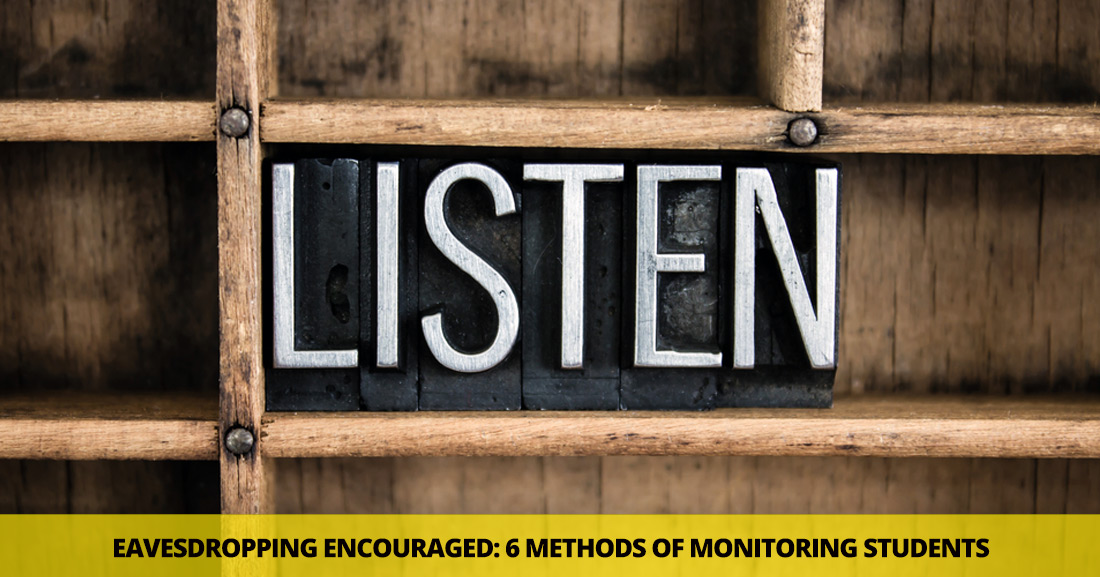Banish Blithering Blabber: 6 Must-Have Components of a Perfect Conversation Lesson


Or maybe you think of large television-like monstrosities that used to plug into your 64 bit computer. Or maybe, just maybe, you think of listening in on student conversations in your classroom, assessing their English speaking abilities. Hopefully, you do think of this last type of monitoring, even if you don’t use that word to identify it. Because in order to really know how well your students are using English, you have to monitor them.
Monitoring is a big word to describe something simple. Listening in might be a simpler way of naming the same action. When you monitor students, you listen to see how well they are speaking English and what areas they might need improvement in.
Monitoring strategies can be divided into two general categories – direct monitoring and indirect monitoring. Like most things in life, each has its advantages and disadvantages. Let’s take a look at each kind.
You can think of indirect monitoring as the sly type of monitoring. Your subtle, spy-like listening in. When you use indirect monitoring, your role is to listen in on what your students are saying, but they don’t know that is what you are doing. When you monitor indirectly, you may listen from the back of the room, from behind your desk, or from another detached location. You’re not zeroing in on one student but are listening to several students at once, and you are listening for mistakes that many students are making. That is, you aren’t just listening to one person for what they are getting wrong.
When you use indirect monitoring, you will follow your session (either immediately or after a short amount of time) with an instruction session. That is when you will address the errors you heard, but you will be addressing them generally rather than pointing out specific mistakes anyone made or quoting their errors. When you give your instruction session, you will be teaching the correct structures to the class as a whole. Because of this, students don’t feel singled out or targeted. The whole class benefits from the correction session since you are talking in general terms rather than addressing individual problems or mistakes.
Direct monitoring is a more obvious, individual-specific way of assessing students. When you monitor directly, you listen to each individual student one at a time and note any mistakes they are making. You might even write down their exact words or errors. Students know that you are listening to them when you use direct monitoring, and they are not surprised when your corrections come immediately after you hear their mistakes. And while this strategy will be more beneficial to individuals because you address their specific mistakes and give immediate feedback, they may also give you a speaking “performance.” In other words, you may not get the most accurate view of their spoken language because they will be giving you their best not their natural spoken English. Still, direct monitoring holds benefits for individual students when you take the time to do it.
Now that you know the difference between direct and indirect monitoring, you’ll have to decide when and how you choose to use each with your class. Here are some suggestions on how to put monitoring into practice.
Sit in on a small group discussion in your class. Use direct monitoring, and give your students feedback as they discuss. Take time to sit in on each of your discussion group over as many days as groups you have.
Have students discuss in small groups. Sit with one group but indirectly monitor the students in another group. Tell the group you are sitting with that you will be observing and not contributing to the conversation, but actually listen and take notes on what the other group is saying.
Have a one on one conversation with someone in your class. You might normally do this as part of a speaking assessment, but rather than giving a grade, give students immediate feedback on any errors they make during your conversation, and don’t record a grade for the session.
Put groups of students to work on a problem. Tell students when they have solved the problem or figured out the solution to come and show their work to you. Then sit at your desk and feign working. Rather than putting together lesson plans, however, listen in on your students as they problem solve and see what errors they are making. Make note of errors you hear from more than one student and put together a plan for teaching the grammar points they need the most help with.
When you do a unit on a controversial issue, include time for a debate. When students talk during the debate presenting their ideas and refuting their opponent’s ideas, pay close attention to the grammatical errors students are making and give less attention to the arguments. Make note of any errors and give a lesson later that day.
Use strategic interaction instead of a more straightforward role play. Divide your class into two groups, and have each group choose a representative to speak for them in the role play, but encourage that representative to continually check in with his group for what to say and how to handle the complex situation he is role playing. Listen in on the discussions between the speaker and his group and note any errors you hear from multiple students.
It gives you a good read on their speaking skills and gives them the feedback and correction they need to become fluent English users. Both direct and indirect monitoring have their time and place, so use both in your classroom. Just be intentional about which you use when so your students can reap the greatest benefits from your feedback.